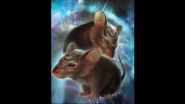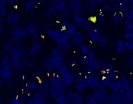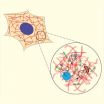(Press-News.org) JUPITER, FL, August 14, 2014 – An international team led by scientists from the Florida campuses of The Scripps Research Institute (TSRI) and the Mayo Clinic have for the first time successfully designed a therapeutic strategy targeting a specific genetic mutation that causes a common form of amyotrophic lateral sclerosis (ALS), better known as Lou Gehrig's disease, as well a type of frontotemporal dementia (FTD).
The scientists developed small-molecule drug candidates and showed they interfere with the synthesis of an abnormal protein that plays a key role in causing both diseases. The team also developed biomarkers that can test the efficacy of this and other therapies.
The study, led by Professor Matthew Disney of TSRI and Professor of Neuroscience Leonard Petrucelli of the Mayo Clinic, was published online ahead of print August 14, 2014 in the journal Neuron.
"Our small molecules target a genetic defect that is by far the most major cause of familial ALS, and if you have this defect you are assured of getting ALS or FTD," Disney said. "Our findings show for the first time that targeting this mutation with a small-molecule drug candidate can inhibit toxic protein translation—and establishes that it could be possible to treat a large number of these patients, but this is just the start of these studies and additional investigations need to be done."
Currently, ALS is usually fatal two to five years after diagnosis, and there is no effective treatment for FTD, a neurodegenerative disease that destroys neurons in the frontal lobes of the brain.
Toxic Buildup
The mutation that can cause both diseases affects a gene known as C90RF72 and involves a repeat expansion, a longer than usual repetitive genetic sequence. This results in abnormal strands of RNA and the production of toxic "c9RAN proteins."
Disney and his Scripps Florida colleagues initially designed three small-molecule drug candidates that decreased RNA translation or production of these toxic proteins in cell culture. The Mayo team developed the patient-derived cell models in which to test the compounds and the biomarker to assess compound activity. Both teams then worked together to show that the lead agent's mode of action was targeting the toxic RNA, binding to and blocking the toxic RNA's ability to interact with other key proteins.
Two of the compounds significantly decreased levels of the toxic protein. Using a series of increasing dosages of the drug candidates, the scientists found that the highest dosage of one reduced the toxic protein by nearly 50 percent.
The scientists also discovered that c9RAN proteins produced by the abnormal RNA can be measured in the spinal fluid of ALS patients. They are now evaluating whether these proteins are also present in spinal fluid of patients diagnosed with FTD.
"A decrease in the levels of toxic proteins in cerebrospinal fluid in response to treatment would demonstrate the drug is working," Petrucelli said. "While additional studies must be done, this finding suggests that these proteins may provide a direct means to measure a patient's response to experimental drugs that target abnormal RNA."
Toxic proteins found in spinal fluid could also become an enrollment tool in human clinical trials, added Disney, who was enthusiastic about the collaboration with the Mayo Clinic and the larger team. "Our collective biological and chemical expertise made this research possible," he said. "This is just the beginning of what we can do together."
INFORMATION:
The first authors of the study, "Discovery of a Biomarker and Lead Small Molecules to Target r(GGGGCC)-Associated Defects in c9FTD/ALS," are Zhaoming Su of TSRI and Yongjie Zhang, Tania F. Gendron and Peter O. Bauer of the Mayo Clinic.
Other authors include Wang-Yong Yang and Erik Fostvedt of TSRI; Jeannie Chew, Karen Jansen-West, Veronique V. Belzil, Pamela Desaro, Amelia Johnston, Karen Overstreet, Bradley F. Boeve, Dennis Dickson, Rosa Rademakers and Kevin B. Boylan of the Mayo Clinic; Mary Kay Floeter of the National Institute of Neurological Disorders and Stroke; Bryan J. Traynor of the National Institute on Aging; Claudia Morelli of the IRCCS Instituto Auxologico Italiano, Milan, Italy; Antonia Ratti and Vincenzo Silani of the IRCCS Instituto Auxologico Italiano, Milan, Italy and the Universita degli Studi di Milano, Milan, Italy; and Robert H. Brown and Jeffrey D. Rothstein of Johns Hopkins University.
The work was supported the National Institute on Aging of the National Institutes of Health (grants R01GM097455, R01AG026251 and P50AG016574); National Institute of Neurological Disorders and Stroke (grants R21NS074121, R21NS079807, R21NS084528, R01NS088689, R01NS063964, R01NS077402 and R01NS050557); the American Recovery and Reinvestment Act of 2009 (awards RC2-NS070-342 and P01NS084974); National Institute of Environmental Health Services (grant R01ES20395); Department of Defense (ALSRP AL130125); Mayo Clinic Foundation; Mayo Clinic Center for Regenerative Medicine; Mayo Clinic Center for Individualized Medicine; ALS Association; Alzheimer's Association; Robert Packard Center for ALS Research at Johns Hopkins; Target ALS; Project ALS; Angel Fund; the Italian Ministry of Health (RF-2009-1473856) and the European Commission.
Common mutation successfully targeted in Lou Gehrig's disease and frontotemporal dementia
2014-08-14
ELSE PRESS RELEASES FROM THIS DATE:
Scientists use lasers to control mouse brain switchboard
2014-08-14
VIDEO:
Scientists studied how just a few nerve cell in the mouse brain may control the switch between internal thoughts and external distractions. Using optogenetics, a technique that uses light-sensitive molecules...
Click here for more information.
Ever wonder why it's hard to focus after a bad night's sleep? Using mice and flashes of light, scientists show that just a few nerve cells in the brain may control the switch between internal thoughts and external distractions. The ...
Long antibiotic treatments: Slowly growing bacteria to blame
2014-08-14
Whether pneumonia or sepsis – infectious diseases are becoming increasingly difficult to treat. One reason for this is the growing antibiotic resistance. But even non-resistant bacteria can survive antibiotics for some time, and that's why treatments need to be continued for several days or weeks. Scientists at the Biozentrum of the University of Basel showed that bacteria with vastly different antibiotic sensitivity coexist within the same tissue. In the scientific journal Cell they report that, in particular, slowly growing pathogens hamper treatment.
Many bacteria ...
Tissue development 'roadmap' created to guide stem cell medicine
2014-08-14
In a boon to stem cell research and regenerative medicine, scientists at Boston Children's Hospital, the Wyss Institute for Biologically Inspired Engineering at Harvard University and Boston University have created a computer algorithm called CellNet as a "roadmap" for cell and tissue engineering, to ensure that cells engineered in the lab have the same favorable properties as cells in our own bodies. CellNet and its application to stem cell engineering are described in two back-to-back papers in the August 14 issue of the journal Cell.
Scientists around the world are ...
Antibodies, together with viral 'inducers,' found to control HIV in mice
2014-08-14
Although HIV can now be effectively suppressed using anti-retroviral drugs, it still comes surging back the moment the flow of drugs is stopped. Latent reservoirs of HIV-infected cells, invisible to the body's immune system and unreachable by pharmaceuticals, ensure that the infection will rebound after therapy is terminated.
But a new strategy devised by researchers at Rockefeller University harnesses the power of broadly neutralizing antibodies against HIV, along with a combination of compounds that induce viral transcription, in order to attack these latent reservoirs ...
Researchers identify a mechanism that stops progression of abnormal cells into cancer
2014-08-14
(Boston)-- Researchers from Boston University School of Medicine (BUSM) report that a tumor suppressor pathway, called the Hippo pathway, is responsible for sensing abnormal chromosome numbers in cells and triggering cell cycle arrest, thus preventing progression into cancer.
Although the link between abnormal cells and tumor suppressor pathways—like that mediated by the well known p53 gene—has been firmly established, the critical steps in between are not well understood. According to the authors, whose work appears in Cell, this work completes at least one of the ...
Researchers develop strategy to combat genetic ALS, FTD
2014-08-14
JACKSONVILLE, Fla. — A team of researchers at Mayo Clinic and The Scripps Research Institute in Florida have developed a new therapeutic strategy to combat the most common genetic risk factor for the neurodegenerative disorders amyotrophic lateral sclerosis (ALS or Lou Gehrig's disease) and frontotemporal dementia (FTD). In the Aug. 14 issue of Neuron, they also report discovery of a potential biomarker to track disease progression and the efficacy of therapies.
The scientists developed a small-molecule drug compound to prevent abnormal cellular processes caused by a ...
Inside the cell, an ocean of buffeting waves
2014-08-14
Cambridge, Mass. – August 14, 2014 – Conventional wisdom holds that the cytoplasm of mammalian cells is a viscous fluid, with organelles and proteins suspended within it, jiggling against one another and drifting at random. However, a new biophysical study led by researchers at Harvard University challenges this model and reveals that those drifting objects are subject to a very different type of environment.
The cytoplasm is actually an elastic gel, it turns out, so it puts up some resistance to simple diffusion. But energetic processes elsewhere in the cell—in the cytoskeleton, ...
Forcing chromosomes into loops may switch off sickle cell disease
2014-08-14
Scientists have altered key biological events in red blood cells, causing the cells to produce a form of hemoglobin normally absent after the newborn period. Because this hemoglobin is not affected by the inherited gene mutation that causes sickle cell disease, the cell culture findings may give rise to a new therapy for the debilitating blood disorder.
The novel approach uses protein-engineering techniques to force chromatin fiber, the substance of chromosomes, into looped structures that contact DNA at specific sites to preferentially activate genes that regulate hemoglobin. ...
NASA sees Tropical Storm Julio now far from Hawaii
2014-08-14
Hurricane Julio moved past the Hawaiian Islands like a car on a highway in the distance, and NASA's Terra satellite captured an image of the storm, now downgraded to a tropical storm located more than 700 miles away. Julio is far enough away from Hawaii so that there are no coastal watches or warnings in effect.
On August 13 at 21:10 UTC (5:10 p.m. EDT), the Moderate Resolution Imaging Spectroradiometer of MODIS instrument aboard NASA's Terra satellite captured a visible image of Hurricane Julio moving through the Central Pacific Ocean. The visible image shows that powerful ...
EARTH Magazine: Are slow-slip earthquakes under Tokyo stressing faults?
2014-08-14
Alexandria, Va. — Tokyo, a city of more than 13 million people, has been devastated by earthquakes in the past and likely will be again. But when? And what role do ongoing slow-slip earthquakes — the kind that generally can't be felt at the surface — play in relieving or building up stress?
New research examining plate movements under Tokyo has found that since the massive magnitude-9 Tohoku earthquake and tsunami in March 2011, recurrence intervals for nondamaging slow-slip quakes beneath Japan's capital have shortened. That has left seismologists wondering if this aseismic ...




